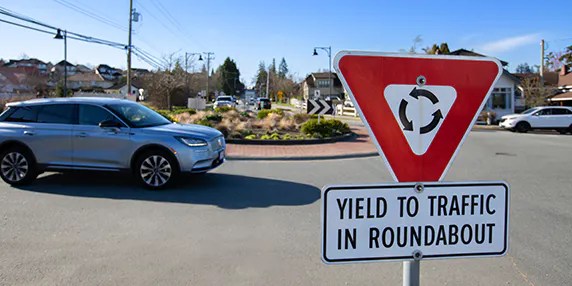Unheard of in the Central Okanagan not so long ago, roundabouts are becoming common in the region.

However, there being more of them doesn’t automatically translate into drivers knowing how to navigate them.
In fact, a new survey by Ipsos on behalf of ICBC says “many B.C. drivers lack confidence when it comes to navigating roundabouts and particularly multi-lane roundabouts.”

“In addition, the survey shows what drivers biggest frustrations are with other drivers when navigating roundabouts,” ICBC said.
The poll surveyed 636 drivers, Jan. 2 to 5, and used a seven-point scale. It also queried those about single-lane roundabouts and multi-lane roundabouts.
“In summary, the confidence levels of drivers are generally higher across all aspects of navigating a single-lane roundabout compared to a multi-lane roundabout,” ICBC said, “indicating a disparity in a driver’s perception of the skill level required to navigate the two types of roundabouts.”
The insurance agency says a majority of drivers express confidence in their overall navigation through a single-lane roundabout, with a rating of six or seven out of seven.
When approaching or navigating the roundabout, drivers seem to feel confident at 59 per cent for both categories. As for exiting the roundabout, drivers are slightly more confident at 62 per cent.

Those numbers dip dramatically, though, when it comes to multi-lane roundabouts.
Only 29 per cent express confidence in navigating those, with male drivers 10 percentage points higher (34 per cent) than female drivers (24 per cent).
The approach confidence is at 37 per cent, navigation confidence is at 31 per cent and exit confidence is at 38 per cent.
“In summary, understanding the right of way and selecting the correct exit out of a roundabout are perceived as relatively easier aspects when navigating a roundabout as a driver,” ICBC said, “while navigating cyclists within a roundabout and navigating marked crosswalks with pedestrians or cyclists while entering or exiting a roundabout pose more of a challenge for a notable percentage of respondents.
“Furthermore, female drivers find cyclist presence within roundabouts, entering and exiting multi-lane roundabouts in the correct lane, and choosing the correct exit out of a roundabout more challenging compared to male drivers.”
ICBC says respondents were provided a list of possible issues or frustrations when driving through a roundabout and were asked to rank them in order.

Topping the list was not yielding to the vehicle that has the right of way at roundabouts (37 per cent), followed by a lack of signalling when exiting a roundabout (16 per cent).
“The survey also shows that 15 per cent of respondents find it difficult to know who has the right of way when entering a roundabout,” ICBC said.
“This correlates with drivers’ biggest frustration when it comes to navigating roundabouts: other drivers not yielding to vehicles that have the right of way.”
Since 2000, around 90 roundabouts have been added to B.C. roadways. ICBC says modern roundabouts can reduce injury crashes by up to 75 per cent as they reduce speed and eliminate head-on, right-angle and left-turn crashes.
“Road design is critical to keeping everyone on our roads safe,” said Shabnem Afzal, ICBC’s director of road safety. “Roundabouts are proven to be highly effective in reducing crashes.
“While common in Europe, they’re relatively newer to Canada. We’re here to offer a refresher and tips so that whether you’re walking, driving or cycling, we all know how to safely navigate roundabouts and share our roads together.”

ICBC says unless lane use signs and markings indicate otherwise, the general rules for a multiple-lane roundabout are as follows:
- Slow down as you approach a roundabout.
- Yield to pedestrians or cyclists.
- Know where you are going.
- Yield to any traffic already in the roundabout.
- Do not change lanes in a roundabout.
- Don’t drive alongside large vehicles in roundabouts.
- Large vehicles may need more space in roundabouts.
- Signal “right” before exiting the roundabout.
In a multi-lane roundabout:
- If you want to turn left, use the left lane.
- If you want to turn right, use the right lane.
- If you want to go straight, use the left or right lane.
If an emergency vehicle approaches and you’re already in the roundabout, finish driving through it and pull over upon exiting so the emergency vehicle can pass
More information about roundabouts is available on ICBC’s website.
- Toronto’s construction season traffic is ‘unacceptable.’ Is there a better way?
- More foreign interference action coming after inquiry report, India arrests: LeBlanc
- Nijjar arrests: Indian foreign minister says Canada welcomes ‘criminals’
- B.C. man losing vision needs to find home for treasured book collection




Comments